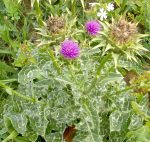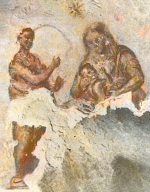
Known by many names including holy thistle, milk thistle and our Lady’s thistle, this annual or biennial is a member of the aster family, Asteraceae, that also includes daisy, sunflower, and lettuce. It is native to the Mediterranean area where it grows in shrubland, woodland, mountains, and deserts. Plants grow 12-79″ tall and have a deep taproot and fleshy grooved stems which may be hollow and/or covered with soft hairs. The shiny green leaves form a basal rosette and are oblong to lanceolate, 6-24″ long, and pinnately lobed with conspicuous white veins and spiny margins. The red-purple flowerheads are 1.5-5″ across and appear from late spring to summer. Each flowerhead is surrounded by hairless, triangular bracts that have spine-edged appendages and a stout yellow spine on its tip. The fruit is a black achene with a large white pappus.

Both the botanical and common names of this plant suggest a connection with Mary, specifically with her breast milk that presumably ran onto the leaves as she was feeding baby Jesus. Although in modern times the image of Mary nursing Jesus is not iconic, from early Christian times to about the 14th century, it was the most popular one. Possibly the earliest image of Mary nursing Jesus comes from the Catacomb of Priscilla on the Via Salaria in Rome that shows baby Jesus nursing on the lap of his mother (right). Over time many images of Maria Lactans (nursing Madonna) were produced by artists including Lucas Cranach the Elder, Albrect Durer, and El Greco (left below). There is no mention in the Bible of Mary nursing Jesus but since her options were limited it is a fair supposition. The only other possibility would have been a wet nurse but if there was such a woman in Jesus’ life some mention would probably have been made of her.
The plant has been grown since ancient times as a medicinal herb and used to treat several problems including liver diseases. Although a possible choice for a Marian garden the plant is generally considered an invasive weed rather than an ornamental.

St. Mary’s thistle likes full sun, and fertile, dry, well-drained soil in USDA Hardiness Zones 5-9. It has no significant pests or diseases and is propagated by seed.
The genus name, Silybum, is from the Greek word silybon that referred to some thistle-like plant. The specific epithet, marianum, honors the Virgin Mary and the legend that the leaf coloration was caused by the Virgin’s Mary’s milk as it ran down the leaves.